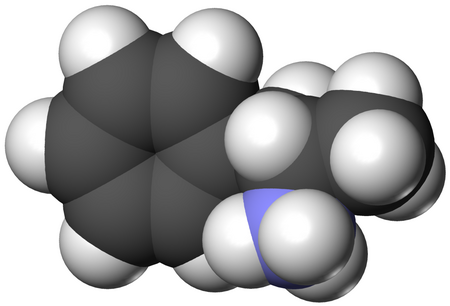الأمفيتامينات (Substituted amphetamine) هي قسم من المركبات المبنية على بنية الأمفيتامين،[1] تشمل جميع المركبات المشتقة المكوَّنة من تعويض أو استبدال ذرة هيدروجن واحدة أو أكثر في البنية التركيبية للأمفيتامين بمستبدلات.[1][2][3] يشمل هذا القسم من المركبات مجموعة متنوعة من الأقسام الفرعية الدوائية منها: المنشطات، المشعِّرات، المهلوسات، وأخرى غيرها.[2] من الأمثلة على الأمفيتامينات المستبدلة: أمفيتامين في حد ذاته،[1][2] ميثامفيتامين، إفيدرين، كاثينون، فينتيرمين، ميفينتيرمين، بوبروبيون، ميثوكسي فينامين، سيليجيلين، أمفيبرامون، بيروفاليرون،[1] MDMA وDOM.
| صنف أدوية | |
|
البنية الراسيمية للأمفيتامين. |
تظهر بعض مشتقات الأمفيتامين المستبدل طبيعيا، على سبيل المثال في أوراق نباتي العلندى والقات، وقد استخدمت هاتين النبتتين منذ القدم (على الأقل منذ ألف سنة مضت) بسبب تأثيراتها الدوائية.[1] تم إنتاج الأمفيتامين أول مرة في نهاية القرن التاسع عشر، وبحلول العقد 1930 استُخدم الأمفيتامين وبعض المركبات المشتقة منه كمزيلات احتقان في معالجة أعراض البرد وكذلك كعوامل نفسية المفعول في بعض الأحيان. تأثيراتها على الجهاز العصبي المركزي متنوعة، لكن يمكن تلخيصها في ثلاث أنشطة متداخلة: تنشيط نفسي، هلوسي ومثير للمشاعر. مختلف مستبدلات الأمفيتامين يمكن أن تحدث هذه التأثيرات وحدها أو في توليفة مع بعضها.
مراجع
- Hagel JM, Krizevski R, Marsolais F, Lewinsohn E, Facchini PJ (2012). "Biosynthesis of amphetamine analogs in plants". Trends Plant Sci. 17 (7): 404–412. doi:10.1016/j.tplants.2012.03.004. PMID 22502775.
Substituted amphetamines, which are also called phenylpropylamino alkaloids, are a diverse group of nitrogen-containing compounds that feature a phenethylamine backbone with a methyl group at the α-position relative to the nitrogen (Figure 1). Countless variation in functional group substitutions has yielded a collection of synthetic drugs with diverse pharmacological properties as stimulants, empathogens and hallucinogens [3]. ... Beyond (1R,2S)-ephedrine and (1S,2S)-pseudoephedrine, myriad other substituted amphetamines have important pharmaceutical applications. The stereochemistry at the α-carbon is often a key determinant of pharmacological activity, with (S)-enantiomers being more potent. For example, (S)-amphetamine, commonly known as d-amphetamine or dextroamphetamine, displays five times greater psychostimulant activity compared with its (R)-isomer [78]. Most such molecules are produced exclusively through chemical syntheses and many are prescribed widely in modern medicine. For example, (S)-amphetamine (Figure 4b), a key ingredient in Adderall® and Dexedrine®, is used to treat attention deficit hyperactivity disorder (ADHD) [79]. ...
[Figure 4](b) Examples of synthetic, pharmaceutically important substituted amphetamines. - Glennon RA (2013). "Phenylisopropylamine stimulants: amphetamine-related agents". In Lemke TL, Williams DA, Roche VF, Zito W (المحررون). Foye's principles of medicinal chemistry (الطبعة 7th). Philadelphia, USA: Wolters Kluwer Health/Lippincott Williams & Wilkins. صفحات 646–648. .
The simplest unsubstituted phenylisopropylamine, 1-phenyl-2-aminopropane, or amphetamine, serves as a common structural template for hallucinogens and psychostimulants. Amphetamine produces central stimulant, anorectic, and sympathomimetic actions, and it is the prototype member of this class (39).
- Lillsunde P, Korte T (March 1991). "Determination of ring- and N-substituted amphetamines as heptafluorobutyryl derivatives". Forensic Sci. Int. 49 (2): 205–213. doi:10.1016/0379-0738(91)90081-s. PMID 1855720.




